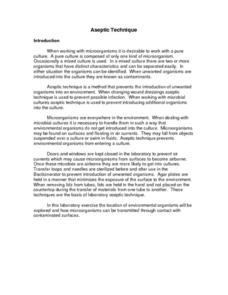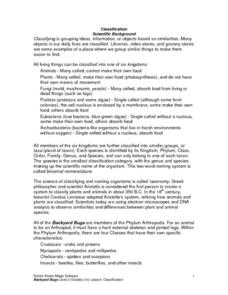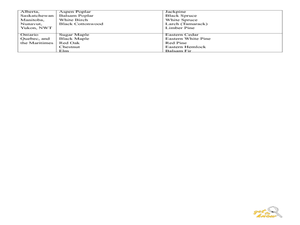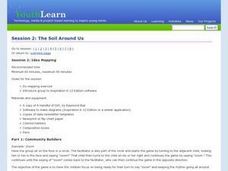Curated OER
Protists and Fungi
Here is an outstanding presentation on protista. It lists general characteristics, and then moves on to describing three different categories of protists. For each, viewers learn physical features, behaviors, and means of reproduction....
American Museum of Natural History
Ocean Creature Feature
From coloring to hard protective shells, ocean creatures have adaptation features that help them survive. An eight-question online quiz highlights different ocean animals and their unique characteristics. The resource then offers pop-up...
Curated OER
Foiling Spoilage
In this agricultural education learning exercise, students read 6 descriptions of bacteria that cause food spoilage. Students then read 4 descriptions of preservatives that can be used to prevent spoilage. The learning exercise is...
Curated OER
Living or Nonliving
Third graders brainstorm a list of the characteristics of living and nonliving organisms. Individually, they find four nonliving and living items and the characteristics that make them fit into one of the categories. To end the lesson...
Curated OER
What is Life?
Students investigate the characteristics of living things. For this life science lesson, students examine several living and non-living specimens. Students determine which things are living and non-living.
Curated OER
Investigating the Uses of Backyard Bacteria
Students discover that the answers to some of society's waste and clean-up problems may be no further than the soil beneath their feet. They perform a Gram stain on the colonies to determine some of their characteristics.
Curated OER
Aseptic Technique
In this microbiology worksheet, learners complete 7 conclusions questions about the aseptic technique they performed in a group lab.
Curated OER
The Origin of Life
In this origin of life worksheet, students write answers to five questions. They describe characteristics of the first life forms and how scientists believe oxygen accumulated in the Earth's atmosphere.
Curated OER
Prokaryotes
Although these slides are text rich, the summaries of prokaryote characteristics will be useful. There are diagrams of preferred cell conditions and your students will find all the basic definitions of structure and functions useful. ...
Curated OER
Food-Borne Illnesses
Use this instructional activity to have your charges consider the differences between food spoilage and food-borne illnesses including the differentiation of food infections and food intoxication, including characteristics of each. Some...
Curated OER
DNA Technologies
After giving some of the basic characteristics of the DNA molecule, the slides provide process information and many detailed diagrams about plasmids, vectors, and their application in cloning genes.
Curated OER
Backyard Bugs
Explore the concept of scientific classification and the similarities and differences between plant and animal species. Your class will participate in hands-on activities by investigating dichotomous keys and classifying their shoes. To...
Curated OER
Micro-organisms
Students discuss micro-organisms. In this micro-organisms instructional activity, students identify which micro-organisms are harmful and which ones are beneficial. Students complete a worksheet which is included in the instructional...
Curated OER
Funky Fomites and Aseptic Microbiology Techniques for Bacterial Isolation
Students listen to a lecture on the purpose of practicing aseptic technique as well as an explanation of how to practice them. They practice aseptic technique by plating bacteria in order to isolate individual colonies of bacteria. They...
Curated OER
Classify the Microbes
Students classify microorganisms into categories based on their characteristics. Pupils use a taxonomic key to identify organisms. They classify certain bacteria, protists, and viruses using a classification or taxonmic key.
Curated OER
Food Safety Lab-Part 3 Cross Contamination andHygiene
High schoolers observe the effect of croos contamination as they inoculate orange juice with penicillin mold from the refrigeration lab and active yeast solution from the sterilization lab. They experience a simulation of passing...
Curated OER
What Is Life?
In this life characteristics worksheet, students answer 16 questions about living things, Redi's experiment, basic needs, growth and development.
Curated OER
Molecular Movement in Water Part 1- Diffusion
Students obseve and compare molecular movement within water at various temperatures and of varying salinity. They discuss the movement of water on a larger scale which can affect the movement and concentrations of microbial populations...
Curated OER
Introducing the Use of Dichotomous Keys to Students
Students are introduced to the use of dichotomous keys as a simple means of beginning scientific observations in nature. They comprehend how to use a dichotomous key. Students distinguish characteristics of a group of organisms. They...
Curated OER
The Kingdoms
Students review the various categories in taxonomy. In groups, they identify the characteristics of each kingdom and compare and contrast them. They define the terms binomial nomenclature and morphology. To end the lesson, they create...
Curated OER
Covalent Compounds
In this covalent compounds worksheet, students answer 8 questions about bonding in covalent compounds, covalent bonds, and diatomic molecules. Students draw 2 dot diagrams showing covalent bonding. They answer 4 questions about bacteria...
Curated OER
Get to Know Trees
Students recognize the characteristics of trees by using their five senses. In this trees lesson, students observe and record the characteristics of trees on a field trip. Students then are blindfolded and use their senses to identify...
Curated OER
Idea Mapping
Students generate, share and display ideas as a group. They break into small groups to work on hand-drawn maps made up of concentric circles. they come before the group and make a similar diagram by charting each other's characteristics.
Curated OER
Micro-Organisms
Young scholars investigate micro-organisms with an on line activity. In this micro-organism on line lesson plan, students identify bacteria, viruses and fungi projected onto a white board. Young scholars work in groups and use a...

























